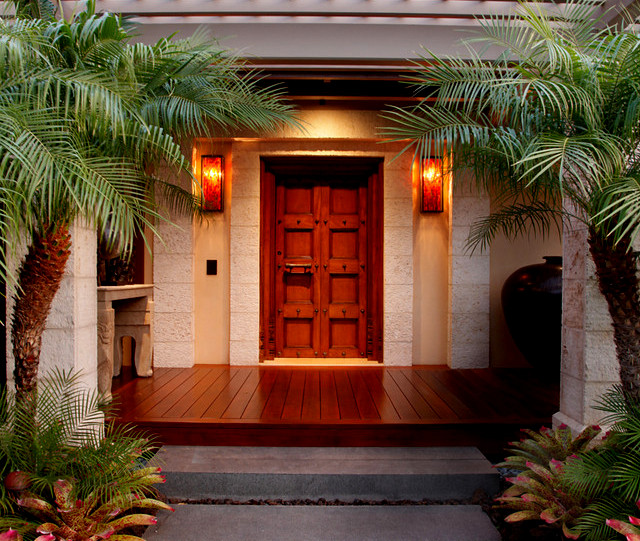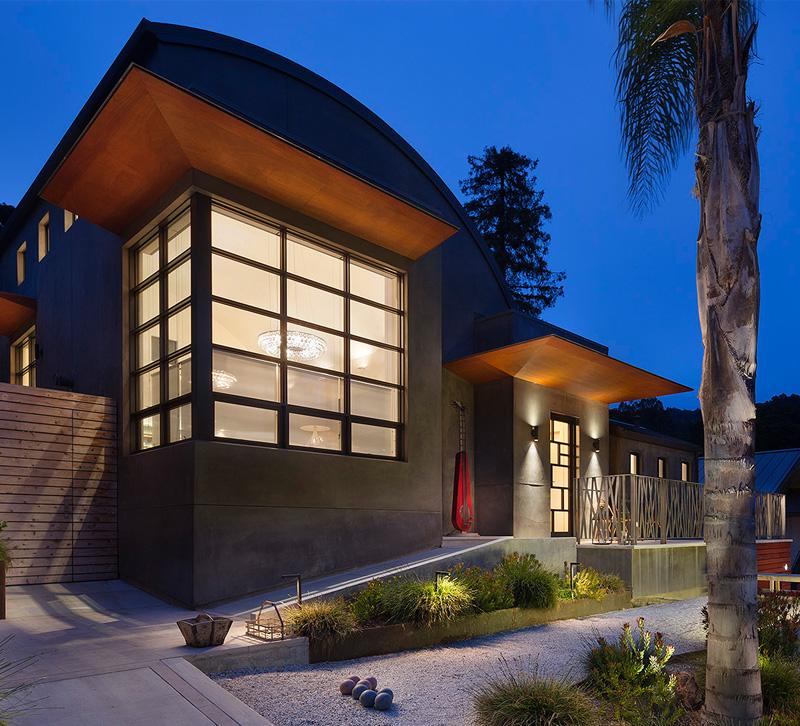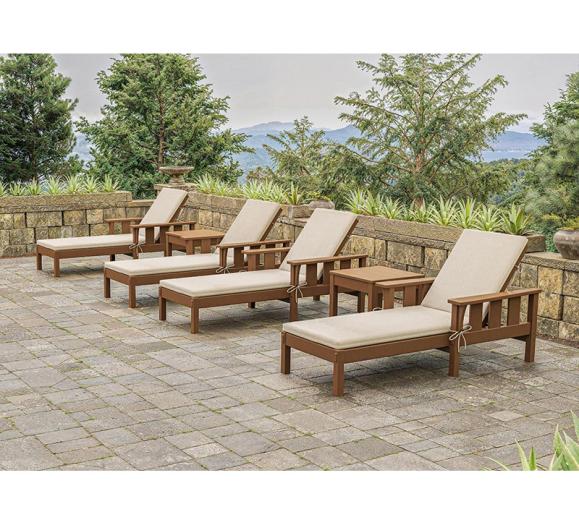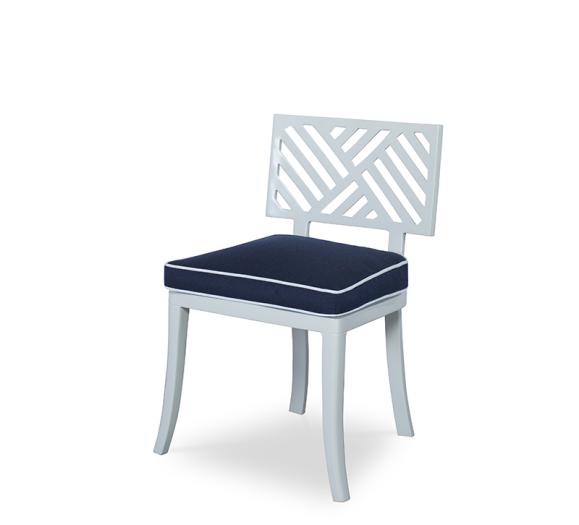To most homeowners, outdoor lighting means a pair of decorative wall sconces by the front door, a few lights along the walkway and perhaps floodlights for security. Exterior lighting can do much more. It can make even a modest property look very attractive at night, increasing the home’s visual appeal and making it more salable in this buyer’s market.
Also, outdoor lighting can make a yard a more enjoyable place to spend time. And surprisingly, exterior lights even can make the interior of a home seem larger and more pleasant. Here’s why: When there’s little or no exterior lighting, windows become black mirrors at night for people inside, making the interior seem smaller and more closed in. By illuminating outdoor areas beyond the windows and glass doors, people see past their own reflections into the outside landscaping. Outdoor lighting can make your home a bit safer too, by deterring burglars.
Mix it up: Outdoor Lighting techniques
The secret to attractive outdoor lighting is using a mixture of different lights and lighting techniques. This keeps the decorative fixtures from being too overwhelming and the landscape lighting from looking like a miniature golf course.

Doorway lighting
Most houses already have one or two fixtures mounted beside the front door. Many homeowners put uncomfortably bright bulbs inside these fixtures, thinking that more light is better. It really just creates more glare and causes the decorative fixtures to take over visually. Instead, install 25W or 40W bulbs to illuminate entryways while minimizing harsh glare and shadows. LED bulbs are now available in traditional shapes, including flame tip. You can get the light output of the 25W to 40W bulb, while only consuming 4W to 6W worth of power. They also last 25,000 hours, as compared to a traditional incandescent bulb, which has a life of 750-2,000 hours. There are even LED bulbs that create the effect of gas flame. Note that they look best in lanterns that have clear or seeded glass. If you put them in a fixture with frosted glass, it just looks like the lantern is having a seizure.
Should you be adding or replacing doorway fixtures, don’t be afraid to “buy big.” Fixtures that seem substantial in the store often look too small when actually installed on your house. Consider borrowing a couple of samples from your local lighting store in two different sizes to see which one looks right from the street. It’s best if you have someone holding up the light fixture up against the house while you go out into the street. You really need to get far enough away to get a good sense of how the scale of the fixture relates to the façade of the house.
Uplighting
These accent lights are positioned on or in the ground and pointed up to dramatically illuminate lawn features such as trees, sculpture or gazebos. Uplights that are recessed into the ground are known as well lights. Ones that are mounted above grade are called ground-mounted directional fixtures. Choose directional lights with hoods or shades so that you don’t see distractingly bright “hot spots” when you look out the window. Use uplights to highlight the yard’s most neatly pruned trees and shrubs, giving them a sculptural quality. Position three uplights around a tree or shrub that’s in the middle of the yard. Use one or two lights if the tree or shrub is located along a fence or next to the home. I favor above-grade uplights over well lights. They’re easier to reposition as a tree continues to grow, and they tend to last longer. Position above-grade uplights behind small plants or shrubs, ideally in mulch beds, to keep them out of view. Uplights and other landscape lighting can be wired in series, with each light connected to another light in the vicinity, and ultimately wired into a transformer, which is located either inside or outside your home. There are some pretty good solar-powered adjustable uplights in the shape of rocks. No wiring required.
Silhouetting
Also known as backlighting, silhouetting is a dramatic uplighting technique appropriate when shrubs or trees with strong sculptural shapes, such as magnolias or evergreens, are located in front of a wall or fence. For this application, a row of uplights is aimed to illuminate the wall or fence behind these trees or shrubs to achieve the desired “wallwashing” effect. The distance between uplights generally should be equal to the distance between the uplights and the wall for the most even illumination.
Path lighting
Path lighting makes strolling on walkways safer after dark, but handled improperly, path lights can make a yard look like an airport runway. To help mitigate this effect, vary the side of the walkway that path lights are placed on, and vary the distance between lights. This creates visual interest and breaks up the runway effect. For safety, place a path light at any point in the walkway where there is a step or change in surface. Select opaque mushroom-type or directional path lights that project light only down. These provide safety without calling excessive attention to themselves.
It used to be that solar-powered path lights were not ideal. They often are underpowered, particularly if trees or the house itself blocks the sun part of the day. However, solar path lights are easy to install and free to operate. If you use them, choose those that project the light only downward. Whether you are using solar-powered pathway lights are not, definitely look for the LEDs versions now, in the 2700K to 3000K range. 2700K is the color of incandescent light at full brightness and 3000K is the color of halogen light at full brightness. Also look for fixtures that have a CRI of 90 or higher. This tells you how close the quality of the light is to that of incandescent.
Downlighting
Downlighting is a good way to light outdoor activity areas, such as outdoor dining tables or cooking areas. They are also very good at lighting planting areas and for projecting a wash of light across grassy areas. Downlights can be mounted on eaves, trellises, gazebos or the branches of mature trees. Their cords can be run down the side of the tree that is viewed least often and held in place by large galvanized staples. Use adjustable straps specifically designed for this purpose to hang lights from trees. If you must screw downlights to branches, use galvanized screws, which are less likely than other types of metal screws to harm the trees.
Moonlighting
Moonlighting is a special downlighting technique. Downlights are hung on tree branches above the lowest branches so that the light filters through the leaves of those low branches, creating a dappled, natural-looking light-and-shadow effect. Other lights might be mounted in these trees, pointed up to highlight the foliage canopy. Mount these lights around 10 to 12 feet up, where they are above the lowest branches but still easy to reach with a standard ladder.
Picking Bulbs
Halogen bulbs traditionally have been used in landscape lighting, but recent advances in LED lights make them the best alternative. LED fixtures are comparable in cost of the old halogens, and they’re more energy-efficient, more reliable in cold weather and can last more than 10 times as long. Make sure to select ones that are rated to be used in enclosed fixtures. Fluorescent bulbs usually are best avoided. They often create light of an unpleasant color and fail in cold weather.
Power Options
Outdoor lighting is available in 120V or 12V systems. The 12V systems are the best choice for most homeowners because they usually can be installed without hiring an electrician and without adding additional circuits to your electrical panel. The cords typically are buried, but if you use a 12V system they don’t pose a safety risk and need not be buried very deep. Transformers are about the size of a half-gallon milk carton. They can be placed in garages or basements, attached to exterior walls or located discreetly in the yard. Lights positioned more than 75 feet from a transformer sometimes are dimmer than those located closer. Installing multiple transformers is one way to solve this problem. LED systems have much less of a chance of having this issue, referred to as voltage drop, because they consume less power for the same amount of lumen output.
Remember, you can’t just choose one of these from the list. You have to use a combination of light sources to create a subtly dramatic and enticing sense of welcome for your home. The bottom line is investing in the outside of your home is money well spent. And while the gratification may not be instant, it's pretty darn close.







